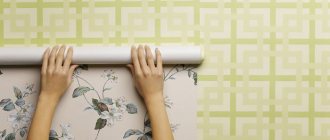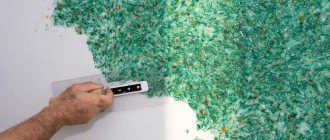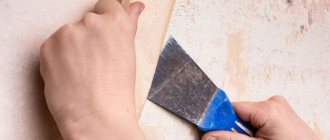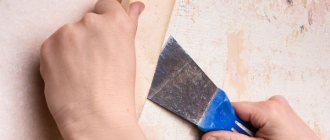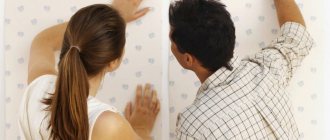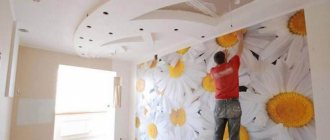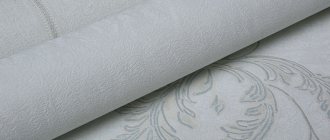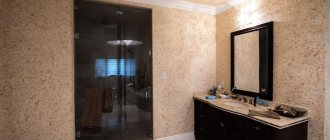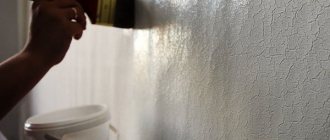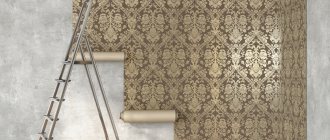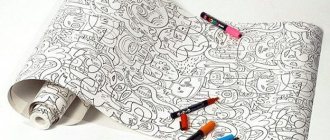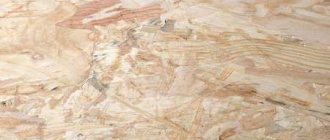Any renovation is not complete without finishing the walls. The walls are covered with wallpaper, but little attention is paid to the rules of wallpapering. If they are not followed, the sheets may come off or blister, ruining the freshly completed repair. But don’t panic or get upset, some skills will help improve the situation. This article describes in detail the reasons why wallpaper may come off the wall and provides useful recommendations for resolving the problem.
Main causes of defects
There are many reasons for the occurrence of defects: from the unpreparedness of the master to the characteristics of the material and glue. These include:
- Wall surface defects. This problem is faced not only by owners of old apartments and houses, but also by new ones. The plaster also comes off due to humidity in the room. Before gluing, you must carefully remove the crumbling plaster and level the wall with a special mixture.
- Improper preparation of the base. An obligatory step is cleaning, priming, and subsequent complete drying of the surface.
- If the walls are made of plasterboard, it is important to carefully process the joints.
- Incorrect application of the composition. Before starting work, you need to read the instructions for the material: what layer to apply, whether two surfaces are applied, how long to wait before gluing. When applying the layer, avoid dry areas.
- The gluing rules were violated: non-compliance with temperature conditions, exclusion of through air, entry of ultraviolet radiation into the room.
- Purchasing low-quality materials.
If compliance with the rules was impossible, it was necessary to postpone the sticking for another time.
Summary
As you can see, gluing and masking the joints along the seams of the wallpaper will not be difficult. It is important not to rush while carrying out work, and also to be careful. In this case, none of the guests will suspect that something was once wrong.
Recommended Posts
3d wallpaper for the living room + photo
Wallpaper Erismann in the interior
Wallpaper painting
Striped wallpaper in the hallway
Do-it-yourself liquid wallpaper: from newspapers, old wallpaper, sawdust, uh...
Paintable wallpaper: glass wallpaper
What will you need for gluing?
You will need clean water for cleaning the instrument and cleaning.
Tools
The following tools are used for gluing:
- Brush for applying adhesive base. It is better to purchase several with different widths.
- A rubberized roller for rolling joints and removing air.
- Dry, clean cloth.
- Putty knife.
- Syringe for removing bubbles.
- Hairdryer for warming up some fragments.
Which glue to choose
If the cause of peeling is a poor-quality adhesive composition, then the peeling wallpaper should be glued with the highest quality composition of another brand or with a special glue for gluing joints.
When gluing a large area, you must use an adhesive composition for finishing materials. You need to choose according to the type of material or universal. The composition is presented in dry form, the solution is prepared immediately before gluing.
If the gluing area is small, then glue for joints is purchased. It is available ready-made, in small volume tubes. In most cases it is universal. Masters distinguish the following brands:
- Metylan – suitable for gluing even heavy wallpaper. It can withstand high temperatures, so it can be glued behind batteries.
- KLEO Strong – suitable for gluing all types of material, does not spread. Becomes transparent after drying. Convenient for gluing behind batteries and in corners.
- RACCORD – reinforced, for gluing joints. Has an applicator for easy application. Strong adhesion without traces.
Many people try to use paste, citing its quick preparation at home. Should not be doing that. This method of gluing will not work, since the paste is not capable of gluing paper impregnated with the composition.
Using PVA is also not an option. It is waterproof, which is bad if you need to remove the wallpaper later. If the glued material is light in color, then the appearance of yellow spots will be noticeable. This glue can be used on an area of no more than three centimeters in dark colors.
Masking the joint
In some cases, after restoration of the wallpaper joint, its appearance leaves much to be desired. It is in such situations that it is quite easy to disguise it. The photo below shows how the raw joint between dark wallpaper looks.
To prevent the eye from constantly falling on a white or other stripe at the junction of the wallpaper, it can be quickly and easily removed by selecting the necessary pigment to match the color of the wallpaper. Water-based paint dyes can be used as a pigment, as seen in the photo below.
You need to choose the option that best matches the color. You can always lighten it by diluting it a little with water. Next, you need to place a small amount of dye on a suitable surface. After this, a spatula or knife is dipped into it, as shown in the photo below.
Next, with a gentle movement, the pigment is applied exactly to the joint between the wallpaper, as shown in the photo below. The seam seems to stand out even more after treatment, but this is easily resolved.
It is enough to take a damp cloth and simply wipe the place where the pigment was applied between the wallpaper and the result will be as seen in the photo below.
Gluing technology
It is important to adhere to the correct gluing technology, follow the rules and principles.
General rules and principles
The principle in gluing is - do not skimp on material. Don't buy a cheap one or on sale because you only need a little bit of it. Discounted goods may be of poor quality due to improper storage.
Before starting work, you need to prepare your workplace, study the instructions for the adhesive, which layer to apply, how long it takes to dry. If possible, complete the work before the start of the heating season to allow the joints to dry at natural temperatures.
Glue peeling wallpaper with the windows and doors closed to prevent peeling again.
Glue joints
If you need to glue it at the joining place, then:
- Move away the edges of the wallpaper using a spatula and clean the surface of the wall and material from debris and dust.
- Apply glue to the wall and material.
- Press with a rubber roller.
- Remove excess with a clean, dry cloth.
We invite you to watch the training video:
Tears and Bubbles
If ruptures and bubbles occur, certain measures are taken. When a bubble forms, carefully pierce the place where it formed with a syringe with glue and squeeze out a sufficient amount. Wait 5-7 minutes until the canvas is completely softened, then press and smooth with a plastic spatula. Remove excess with a rag.
The bubble can be removed by cutting it with a special construction knife. But this option is possible if the wallpaper is without a pattern. Otherwise, a mismatch will occur. When making a cut, the cavity is also filled with a syringe, time is waited and pressed with a roller.
To get rid of tears, it is enough to treat this place with glue, wait a little and carefully connect the fabric.
Defects are eliminated on a well-moistened cloth. Such corrections cannot be carried out dry.
Wallpapering after the cat
If your beloved cat has ruined part of the covering, then this can always be corrected. To do this, you need to have the same piece of canvas and adhesive. The damaged piece is carefully cut out with a construction knife, the wall is processed, glue is applied, a few minutes are waited and a new strip is applied to the wall. Smooth out using a roller or rag.
If there is an animal in the house or apartment, it is better to glue non-woven material to the walls, or better to paint the walls.
How to re-glue a large area
There are some peculiarities and sequences in re-gluing a large area:
- Before starting work, we eliminate possible drafts.
- We remove debris from the peeled canvas. Debris is also swept away from the wall, excess putty is removed and processed.
- The canvas is spread with the adhesive mixture and soaked for at least 7 minutes. The time increases due to the already existing layer of glue from the first time.
- Apply glue to the wall without touching the glued wallpaper nearby.
- Straighten the strip and apply it to the wall.
- Press and expel excess composition and air with a rubber roller, rag or plastic spatula.
- Treat the joint on top, wait a few minutes, and remove excess with a rag.
Do not open windows until completely dry.
Bonding non-woven fabrics
The non-woven base has its own gluing characteristics. Incorrect application of wallpaper with such a base will lead to its peeling off. There are always instructions for such material, the study of which is mandatory.
This base is glued using glue and a spatula. The joints and the wall are treated with a special mixture, wait at least ten minutes (this material is much denser than ordinary paper wallpaper). Press and smooth with a roller or plastic spatula. Excess is removed with a rag or cloth.
How to glue wallpaper without glue
You can glue fallen wallpaper without a special composition, but prepare your own paste. This option is cheap, but impractical. It’s better not to experiment, especially if peeling has already occurred. It is not recommended to use either paste or PVA during work.
How to carry out repairs correctly?
If a strip of wallpaper has come off near the ceiling or floor, then to re-glue you need:
- Take wallpaper glue, which you dilute to a liquid state.
- The fallen part of the canvas must be thoroughly coated with adhesive, wait about five minutes, and then carefully returned to the wall.
Important
The room being renovated should be kept closed from drafts for 2 days.
It is very important to know what you can use to glue wallpaper that has come off at the seam.:
- It is necessary to arm yourself with a spatula, carefully bend the edges, and clean the canvas and wall of debris.
- Then you need to apply glue to the peeled off area and press it back to the wall, using a rubber roller to make sure.
- Wipe off excess glue with a dry, clean rag. Non-woven and vinyl wallpapers are not afraid of water, so they can be wiped with a damp cloth, while paper wallpapers can only be wiped with a dry cloth.
Expert advice
Experts highlight several tips when gluing wallpaper:
- Use high-quality materials for repairs.
- The loose edges are cleaned of debris and coated with the same compound that was used during the repair, only diluted with a more liquid one.
- PVA can help, but in the future there will be difficulties with peeling off and yellow spots may appear. Therefore, its use should be avoided.
- The material will rupture when the wallpaper and plaster come off. In this case, you should remove the canvas, clean it, the wall and make a new pasting.
- The material for gluing is purchased with a reserve, which will allow you to resort to replacement when gluing the room.
- If a whole panel is being re-glued, and there are sockets or switches on it, measures are taken for preliminary removal.
- The moment is taken into account when selecting the composition for working with different types of wallpaper.
- The floor for coating the canvas must always be clean.
- Prepare rags without patterns to prevent the pattern from transferring to the material when wet.
Grouting joints
For plain canvases, you can use a method that will not only glue the joint, but also disguise it well. To implement your plan, you will need regular PVA glue and gypsum putty for walls.
The components must be poured into a small bowl and mixed together. The ratio should be 1:1. Mixing must be thorough so that there are no lumps left in the composition, as they will create problems. The photo below shows that you can use a regular spatula and a plastic container for mixing.
After you have achieved the required consistency, you need to carefully apply the composition to the joint. In this case, the wallpaper must be pressed against the wall and moved well together.
The photo above shows that the composition must be applied directly to the joint between the wallpaper, and a rubber spatula for grouting the joints between the tiles can be an assistant in this. After application, the composition must be given a few minutes to penetrate into the materials.
After this, you need to take a good cloth that does not have lint, moisten it and gently wipe the treated joint. The result will be perfect. If the wallpaper is plain, but not light, then you can add a pigment to the resulting composition that best suits the specific canvas.
What kind of wallpaper can be glued on a vinyl base?
Sometimes you can start gluing other canvases on top of the vinyl base. This is possible under certain conditions; the condition of the coating is assessed. You cannot glue in the following situations:
- It is prohibited to stick over stripes that are falling off or with empty areas. Check the surface by running your hand over it; there will be cracking sounds in these areas;
- Some of the sheets are torn, the joints are peeling off from the wall.
When the base is held securely, no flaws are found. Then they act in the following steps:
- Use a spatula to carefully remove the top layer, starting from the top, removing the edges.
- Holding the separated edges, slowly remove the entire canvas, leaving a paper base.
- Apply a special adhesive solution; when it dries, you can glue the wallpaper.
It is recommended to treat the base of vinyl wallpaper after removing the top layer with sandpaper.
If the base is held securely and no flaws are found, then you can glue the wallpaper on top.
Leveling the surface
One of the mistakes is poor leveling of the wall before pasting. Unfortunately, using wallpaper you won’t be able to make curved walls straight. Depressions, protrusions and cracks become even more noticeable after pasting. Even small grains of sand and fallen pieces of putty appear on the surface and are noticeable.
Can a wall with old wallpaper be considered well-lined? It is probably possible if you first make sure that the wallpaper does not bubble over the entire surface, lies perfectly flat, and has no wrinkles, cracks or tears. But this should not be paper wallpaper with overlapping joints: the joints will also show through, and steps will appear under the new wallpaper, which will spoil the appearance. For the same reason, the old coating should not have any relief, volumetric decorative elements or other irregularities. The surface should be completely smooth and resemble paper in texture. This is rare with vinyl flooring.
Special edge adhesive – is it effective?
On the market you can find a special composition that is used to glue the edges of wallpaper. It is convenient, easy to use and allows you to properly glue the joint. The most popular brands from well-known brands are as follows:
- Kleo.
- Quelyd.
- Metylan.
The features of such compositions are as follows:
- The substance sets to the surface very quickly, gluing weak spots.
- It does not require dilution or preparation. It is sold in tubes, ready to use.
- Thanks to the convenient packaging (tube), the process is quick and easy. And thanks to the dispenser, you won’t be able to overdo it with the substance.
- Some manufacturers include a brush with the tube, which is easy to apply the mixture in hard-to-reach places.
- Excess substance can be easily removed with a damp cloth before it dries.
- The product is universal, which means it is suitable for any type of wallpaper: non-woven, paper, fabric, vinyl.
After drying, the adhesive will not dissolve with water and will not become wet. This means that even high humidity in the room will not be able to weaken adhesion to the surface. Working with the tube is very simple: just apply the substance to the wall or joint and press the area with a dry cloth. The optimal temperature for operation is +10–25 ℃. Is this method effective? Yes!
Pros and cons of the solution
The advantages include saving time and effort on removing the finish. However, the solution has many more disadvantages. Such a decision can lead to the paintings falling off ahead of time. Defects and stains from the coating may appear on the coating.
Wallpaper that does not adhere well will constantly peel off, and you will have to correct the pasting each time. For these reasons, experts say that repairs cannot be carried out in this way.
Such a decision can lead to the paintings falling off ahead of time.
Everyone decides for themselves whether to glue vinyl wallpaper onto vinyl, but if the owner of the room wants to get a high-quality and durable result, then this should not be done. It is better to remove the coating than to look at a damaged new sheet that will constantly peel off or even completely fall off the wall.
Why are the coverings coming off the wall?
It happens that everything was done according to the instructions, but the wallpaper came away from the base. The main reasons for peeling off:
- Surface defects. The phenomenon is not uncommon, since the walls are deformed or initially uneven. Before finishing work begins, poorly adhering plaster should be removed and all visible cracks should be filled with putty.
- The installation of walls made of plasterboard sheets was carried out incorrectly. The joints between the sheets were poorly processed.
- The surfaces for gluing are unsatisfactorily prepared. Probably, they still have the same wallpaper or traces of painting or whitewashing (find out how to remove liquid wallpaper, photo wallpaper, and washable wallpaper). The situation will become more complicated if they are not primed in advance (why prime the walls for wallpaper and how to do it?). This is an invariable stage of gluing materials.
- The wallpaper was applied to a damp surface, wet primer or plaster.
- Wallpaper glue applied unevenly. This is a common mistake. Troubles are possible if the paste is applied with a brush rather than a roller. Gaps and areas without adhesive appear on the canvas (how and with what do you apply glue to wallpaper?).
Important
To ensure that the materials do not move away from the base, it is necessary to ensure that the drying process is correct.
To do this, it is recommended to do the following:
- Keep doors and windows closed for the first days.
- To avoid drafts, close the ventilation.
- Curtain the windows so that the sun's rays do not fall on the wallpaper.
Often the stripes come off and bubbles appear if the room is cool or the air humidity is high.
